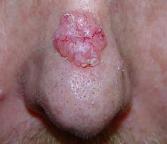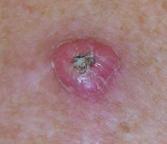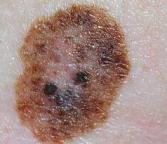
Skin Cancer
Cancer is a disease where cells divide uncontrollably and may invade adjacent tissues and metastasize (spread to distant parts of the body). The skin is divided into three main layers - epidermis, dermis and subcutaneous tissue. Most skin cancers originate from cells within the epidermis (top layer). As these cells grow and divide in an unregulated manner, they can invade the dermis where they have access to the lymphatic system to spread to distant body sites.
The three most common types of skin cancer are basal cell carcinoma, squamous cell carcinoma, and melanoma. These are grouped into the non-melanoma skin cancers (NMSC) and melanoma skin cancers. Factors that increase the risk of NMSCs include excessive UV radiation, chronic non-healing sores or wounds, x-ray exposure, immunosuppression and exposure to certain chemicals like arsenic.
 |
 |
 |
Basal Cell Carcinoma |
Squamous Cell Carcinoma |
Melanoma |
Basal cell carcinoma is the most common type of skin cancer, accounting for 75% of all skin cancers. Approximately 2 million Americans are affected each year. They are primarily located on sun-exposed areas of skin such as the head and neck. These cancers rarely metastasize but can create significant local destruction if not treated promptly. People who have had one basal cell carcinoma are also at an increased risk of developing others, either in the same area or another part of the body.
Squamous cell carcinoma is the second most common type of skin cancer, composing approximately 20% of all skin cancers. More than a quarter of a million cases are diagnosed in the US each year. A small percentage of squamous cell cancers that originate in the skin spread to the lymph nodes and other organs. Squamous cell carcinomas can also originate in organs other than the skin such as the lungs, mouth and cervix. Again, as skin cancers, these mainly occur on sun-exposed areas.
What is melanoma?
Melanoma is the most serious form of skin cancer, accounting for about three quarters of all deaths caused by skin cancer. It is caused by the uncontrolled growth of pigment-producing cells called melanocytes. Melanocytes are cells found in the basal layer of the skin and produce the pigment melanin which gives color to your skin. Melanocytes can also clump together and form nevi (commonly known as moles). Unfortunately, if these cells mutate and their growth become unregulated, they can invade and damage internal organs.
What causes melanoma?
We do not know what exactly causes melanoma but doctors and scientists believe that genetics and the environment both play a role. Although we cannot explain why one person gets melanoma and another does not, research has shown that there are factors that increases a person's risk of developing melanoma:
Excessive ultraviolet light exposure
Ultraviolet light from the sun and tanning beds can cause changes in our skin cells' DNA causing them to grow uncontrollably and spread to other organs.
History of sunburn
Having blistering sunburns, especially as a child or teenager, increases one's risk several-fold.
Having many moles or unusual moles
People with lots of moles or unusual looking moles (called dysplastic nevi) are at an increased risk. These people should watch these moles regularly see if they change.
Fair skin
People with fair skin, light colored hair and light colored eyes have a increased risk of melanoma because there is less melanin, the pigment that gives your skin color and also protects you from damaging UV rays, in the skin.
A family history of melanoma
Genes and the environment both play a role in the development of melanoma. Some mutations in a person's DNA that causes melanoma may be passed on to subsequent generations. We are in the process of discovering new mutations that can cause melanoma.
Weakened immune system
People who are on immunosuppressive drugs (say, after an organ transplant) or have weakened immune systems are more susceptible because the body's defense mechanisms are not as adept to destroy mutated cells.
Age
The risk of melanoma goes up with age, but it tends to occur in younger people compared to other cancers.
What does skin cancer look like?
NMSC (non-melanoma skin cancers) can look like non-healing sores.
For melanoma, look for the ABCDE's:
A Asymmetry: One half of the mole does not match the other half in size or shape.
B Border: The borders of the mole are irregular.
C Color: The color of the mole is not the same throughout.
D Diameter: The mole is larger than 6 millimeters, which is about the size of a pencil eraser.
E Evolution: The mole is changing in any way. This includes its size, shape or color.
Skin Cancer Prevention Guidelines
Wear sunscreen daily
Avoid tanning beds
Protect yourself from the sun
Skin Exam
Photos courtesy of Dr. David Sheinbein and Dr. Susan Bayliss
Photos used with permission from the SPOTS (Sun Protection Outreach Teaching by Students) Training Manual.
Contact Us: skincancer@dom.wustl.edu
